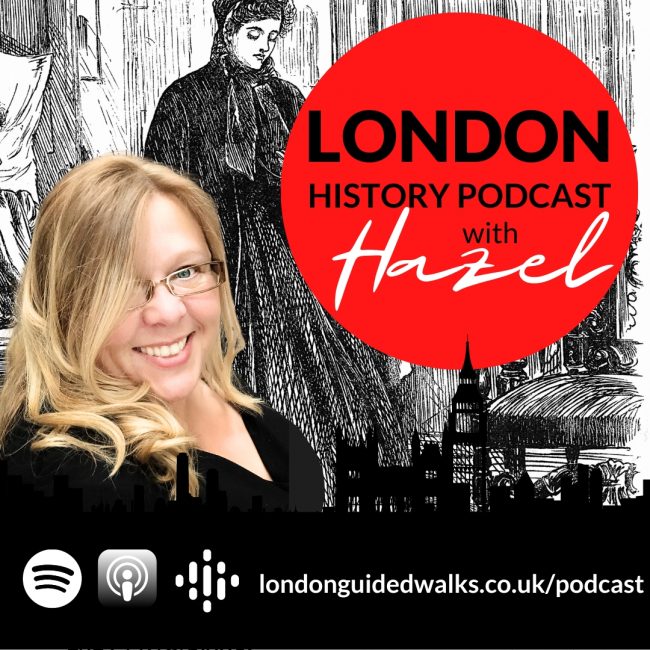Show Notes:
 Hazel Baker: Hello and welcome to London Guided Walks London History podcast. In the coming episodes, we will be sharing our love and passion for London, its people, places and history in an espresso shot with a splash of personality. For those of you who don’t know me, I am Hazel Baker, founder of London Guided Walks, providing guided walks and private tours to Londoners and visitors alike.
Hazel Baker: Hello and welcome to London Guided Walks London History podcast. In the coming episodes, we will be sharing our love and passion for London, its people, places and history in an espresso shot with a splash of personality. For those of you who don’t know me, I am Hazel Baker, founder of London Guided Walks, providing guided walks and private tours to Londoners and visitors alike.
Don’t forget we also transcribe all of our episodes. So if you want to read what we’re also saying, then please visit londonguidedwalks.co.uk/podcast, click on the episode that you want, and you’ll be able to have the transcript and any images or anything else that we will have to share, we put it there.
Reviews for our podcasts are great appreciated. They help us build awareness for the show, which in turn allows us to ensure we bring the best value to our lovely listeners like you. Not only that, but they help us better understand what matters to you most. And we can make improvements in turn, which benefit everyone. You can easily leave a review by clicking on the five stars, or you can write a little bit about what you enjoyed most about our podcasts. That’s enough of that. Let’s get on with the show.
Joining me in the studio today is City of London Tour Guide Ian McDiarmid.
 Ian McDiarmid: Hello.
Ian McDiarmid: Hello.
Hazel Baker: So Ian, today we’re going to be focusing on guilds in the City of London, but mainly through Medieval times.
Ian McDiarmid: Yes, we are.
Hazel Baker: So first question, what is a guild?
Ian McDiarmid: Well it’s simply an association of people, we’re talking men by large, who come together either for purposes of promoting their interests in their trade or come together for religious purposes.
Hazel Baker: So why the word Guild? Why not association or group?
Ian McDiarmid: It’s just medieval English. It probably comes from the same roots as the German guilt money. And it’s to do with paying Jews into the club if you like.
Hazel Baker: So it’s basically a membership club.
Ian McDiarmid: Yes.
Hazel Baker: And how did they start?
Ian McDiarmid: Well, they go right back. So there’s references to them in Anglo-Saxon times. But what’s interesting is that they become formalized really in the 14th and 15th centuries. So we we’ve got records from, we’ve got substantial records from the 14th and 15th centuries onwards. And as normal, whenever we’re talking about things historical, it’s dangerous to argue from an absence of evidence, but the fact that we don’t have formal records before the 14th century, it’s probably reasonable to conclude that they existed, but they were informal associations with people before that time.
And what’s interesting in the 14th and 15th centuries is you begin to get two kinds of records. You can begin to get the internal administrative records of them as an organization, either employing somebody to test or record their minarets and what they’ve been up to. And before 1400, we’ve only got these for about three guilds, and then they sort of mushroom after that.
And then the other kind of evidence is them trying to get some official form of recognition, and you could get this from three sources. You could get it from the church. You could get it from the Lord Mayor and the Alderman in the City of London. And you could get it from the crown. And from the church, what would happen would be, a religious Guild. One that’s men coming together for ceremonial purposes to say prayers, say prayers for the dead, basically gets taken over by a commercial guild. And this is what happened with the Salters. They take over a Guild in Bread St, guild of Corpus Christi or Hallows in Bread St. And this may sound a little bit strange, but in the early past the middle ages, the trades tended to live together. And I’m sure there’s some kind of economic term for this, but it makes sense if you want to go and buy assault. For example you want to buy a bit of arm work. It makes sense for all the people selling that to congregate together so that somebody who wants to buy it can just walk from one store to another.
Hazel Baker: Well you see this even in modern day. If you want to buy a mobile phone, you will notice that, you know, it was Cathaway house and orange and three, they would all have their shops right next to each other.
Ian McDiarmid: Yeah. It’s a phenomenal that you and I know about, and there’s probably some short term economic phrase to cover it. It’s just, we don’t know what it is. Yeah. So they will come, so the Salters and everybody else would be living together originally. And so it would make sense for them to, if they were forming to dominate these religious guilds as well. And then the religious guild could quite naturally be just be taken over, to act as a trade guild.
More common ways for them to come in together, they wish to seek recognition from the Lord Mayor and Alderman. And this is where you get a series of ordinances saying, this is how we’re going to run our Guild. And then the corporation of London has manifested by the Mayor and the Alderman would recognize that. And that will give you some kind of official power to impose your regulations and above all, to be able to impose your monopoly.
And the third source of recognition, which became increasingly important in the 14th century was the crown. And what guilds do, so for example, the Skinners do this in 13, 27, same years, the merchant tailors, they get a charter from the crown recognizing them. And they have to pay the crown money for this very convenient for the Kings of England who are frequently impecunious. But it gives the guild great advantages. Once you’ve got a charter, you are technically incorporated, which means that you can act as a corporate body. Very useful if you want to undertake law cases. And crucially, it means that you can be left in dominant in perpetuity. So people can give you a grant of land or something. And because you’ve got this recognition through the charter, that land given to you as a Guild will stay with you forever. But it’s significant that we have guilds surviving today and they survive for this reason.
Hazel Baker: And so Medieval London, they’re at that peak. How many were there?
Ian McDiarmid: About 50 and we need to divide them between the big prosperous guilds. Those four merchants. So we’re talking about the elite of the London community here. People like the Mercers. Mercers deal in high-end textiles like silk. The Drapers who are also dealing in textiles, but they’re mainly interested with the export of wool and cloth. The Grocers who are basically importing spices and spices are incredibly expensive. The Fish Mongers are there, quite a lot at the time. And also the Goldsmiths.
And we’ve got an ordinance from the early 16th century, which gives the order of precedents of the guilds. And this probably reflects roughly the order of precedents that they always had though they would be changing position every now and then they were very interested in their position on this. And the Top 12, they’re known as The Great 12 and they are the ones at the top of the ones I’ve just mentioned.
So the first Guild, the one that heads the list is the Mercers. And then beneath them, you’ve got the more ordinary worker day guilds, people like the weavers. And one good distinction between these would be between the Skinners who amongst the big. They ranked six or seventh in the list that has come down to us. And the Tawyers, and the Tawyers were people who made white leather.
Hazel Baker: So these secret societies, what did they do?
Ian McDiarmid: Well they had three main functions: economic, religious, and social. So the economic one is the most important one. And the most important aspect of this is imposing a monopoly. If you wanted to sell anything in within the City of London, you had to be a member of the Guild. And if you weren’t, if you were selling stuff illegally, they would take action against you. And imposing a monopoly is obviously in their interest because it enables them to keep prices artificially high. They also restrict the supply of labour coming into their trades and they do this through the apprenticeship scheme.
If you want to become a member of the Guild, you can do it by paying. You can do it by, if your father is a member of the Guild, but the main way increasingly so in the middle ages is to serve an apprenticeship. And the apprenticeship vary in terms of years, but they, technically between five and seven. So you have to have done this to be able to practice a trade. And again, this restricts the supply of people who are able to indulge in the trade and therefore keep prices high.
Hazel Baker: It also means that the quality of the standard of work surely is standardized and it’s kept high as well.
Ian McDiarmid: Yes. And this is the other aspect that’s very important. You can imagine that in Medieval London, you’ve got no standardization of goods. You’ve got no trademarks. And if you’re a consumer it’s vitally important for everyone concerned that you have faith in what you’re buying. Important for the consumer so they know what they’re getting. But also important for the people selling them because you want to encourage people to come back and buy again.
And the idea is that if you buy something from a guild, you are assured of the quality. And so you’ve mentioned the apprenticeship schemes, which implies that the people are fully trained, but also, they are very hot on quality assurance. They regulate this very very strictly, and they’re very, very tough on people who try to sell substandard goods. And there are all kinds of ritual punishments that we know about. So for example, if you were a butcher and you sold rotten meat, there’s an example of somebody having the awful, the offended being placed in the stocks and having the offended, awful being burnt in front of their nose.
If you were a baker, we get the phrase baker’s dozen meaning 13. Because a baker’s batch of loaves would be 12, but you make a 13th, so it can be inspected. And again, if the loaf was of substandard, you might find yourself put on a trestle and dragged around the city with the offending loaf tied around your neck usually.
Hazel Baker: Naughty.
Ian McDiarmid: And the central point about these punishments obviously is humiliation and it’s in a face-to-face society in which prestige, respectability, is of crucial importance.
Hazel Baker: That’s right. And it also shows that justice has been done as well.
Ian McDiarmid: Yes, it shows, yes. It was showing that the guilds are caring.
Hazel Baker: Well what’s the worst thing that could happen if you were found to be below par?
Ian McDiarmid: Well ultimately they can expel you. And that means you can’t make a living. They were in addition responsible for the actual price fixing of a lot of goods. And there were lots of goods that were deemed to be essential to everyday life. Things like bread, salts, wine. And the prices were fixed in by the government but basically in the process of negotiation with the guilds. And this meant that they could sell stuff at a good price much of the time. But it also meant that in times of scarcity, they couldn’t price guards.
So if there was a bad harvest, the bakers could not just put up the prices to what the market would bear. And this is in form by two things. One is the concern for social order, but it’s also this concept that they have then of the just price that they don’t like speculators. And they don’t like price gougers as we would call them now. So they fulfil these very important. Economic functions and they absolutely dominate the economic life of London in the middle ages.
And then beyond that, they’re also religious associations. So we’ve mentioned already that some of the trades actually grow out of what a purely religious association sometimes called confraternities. But the guilds always had important religious functions. The most important perhaps is ensuring that you get a decent burial. So funerals cost a lot of money. Again, it’s to do with prestige. If you remember the Guild, the Guild will give you a good send off. and some of the guilds have got their palls. Funeral palls surviving. And a few years ago there was, an exhibition of medieval embroidery at the Victoria and Albert.
Hazel Baker: Oh I remember that one.
Ian McDiarmid: And the highlight. Well, in my opinion.
Hazel Baker: Behind the glass, I remember that.
Ian McDiarmid: At the end was the pall belonging to a Fish Monger.
Hazel Baker: Yeah sorry for getting overexcited about this. Yeah this was an exhibition back in 2017, wasn’t it? It was about masterpieces of English Medieval embroidery. And it had some of the most outstanding examples of English Medieval embroidery that I have ever, ever seen. And yeah, you’re absolutely right. The Fishmongers pall, which is about early 1500. This was not the PST resistance at the end of the exhibition. And it was simply beautiful.
Ian McDiarmid: And perhaps I should just explain what a pall is. It’s a cloth that goes over your beer or your coffin.
Hazel Baker: And it looks fabulous, doesn’t it? You know, it can be really, really quite blink. And it’s not for one use. They’ll use it for everybody.
Ian McDiarmid: Yeah. The pall in the VNA was absolutely superb, wasn’t it?
Hazel Baker: I know. Exquisite.
Ian McDiarmid: Yeah. I’m not sure how often they have it on display. The fish mongers. That is probably not that often.
Hazel Baker: No. At the Impalth. they have their pall on display.
Ian McDiarmid: Do they?
Hazel Baker: Yeah. Yeah, they do. But it’s interesting because you’re saying all these guilds with men meeting, I don’t think any of them embroidered a pall.
Ian McDiarmid: No, we could go onto women and guilds. There were only a couple of women in them. Sometimes women would inherit their fathers’, would inherit a place in the Guild if there were no sons. So there were a couple of women, they weren’t completely excluded, but largely excluded.
So yeah, we talked about them getting a good send off. The other important thing is purgatory. So the Catholic church introduces purgatory, I think about the 12th century might, I think about then. But anyway, it’s certainly up and going as an idea by the 14th and 15th centuries,
Hazel Baker: And this is like, Dante’s Inferno. You’re not in heaven yet. You’ve got to work your way through, haven’t you?
Ian McDiarmid: Yeah and the way they describe purgatory is that it sounds a lot more like hell than it does. And then heaven say, but the crucial thing with purgatory is you can get out of it. And your way out of it can be speeded up by people on the outside. That is the quick, the people who are alive saying prayers for you. And these prayers are known as orbits, and you can leave money to have all that set for you, but also the guild will have prayers for the members. So this is one of the important benefits of being a member of the Guild.
And also we shouldn’t forget that they are just places of conviviality. So it’s about men getting together and having a good time. So all of the guilds would have a feast day of their foundation and which would be dedicated to the Patron Saint. And a lot of it is about men dressing up in their livery. And another word for guilds is livery companies. Their Guild uniforms it were and getting pissed essentially. Can I say pissed, Hazel?
Hazel Baker: You’ve said it twice. So you mentioned before that they have an order of precedence and surely that’s got to have been contentious. I mean, who says that you’re number three or number four?
Ian McDiarmid: Well, indeed. And I’m saying that the Mercers were number one, but there’s some indication that before then, The Grocers had vied with them for this top spot and they were all, they were very, very sensitive on the point of precedence. And I think I mentioned very briefly that the Skinners are either sixth or seventh and they have this ritual whereby they change places each year with the merchant tailors. And this goes back to one of the Lord Mayor’s shows, processions in the 15th century. So in the 15th century or indeed in the middle ages, the Lord Mayor’s procession took place on the river. And one year, the merchant tailors and the Skinners who were always fighting with each other for precedence, turn this into their own private boat race, and it got violent. And some people lost their lives. And as a result of that, the Lord Mayor came in with this ruling that they should alternate between one should be sixth one year and the other one should be sixth the following year. So it was very curious. So the order of precedence was always a source of potential conflict.
Hazel Baker: Is this something that you hear, don’t you? Say I’m all at sixes and sevens?
Ian McDiarmid: Yes. A lot of people think that this comes from this thing about the Skinners and the merchant tailor’s alternating. Unfortunately, I think that the phrase we’re at sixth and seventh predates this, I think it may get a mention in Chaucer, but it’s rather than my story, isn’t it, it’s probably a kind of 15th century humour of, the Lord Mayor being very witty by saying this thing about sixes and sevens, because it perhaps fitted in with an existing phrase. So probably not, unfortunately.
The other big source of potential problem with them was their monopolies. So I’ve already mentioned the Tawyers and the Skinners, but they’re all kinds of way the trades overlapped. I remember when I first started doing guiding on guilds, I had to check on the difference between a cordwainer and a cobbler, because I didn’t know.
Hazel Baker: And what is the difference?
Ian McDiarmid: Well cordwainer make shoes and a cobbler repairs them. Yes, but they were getting into conflict and you can just sort of see. Also, another one, I don’t think they did conflict, but you can imagine the tally Chandlers and the wax Chandlers having, and so it goes on there, all these overlapping.
Hazel Baker: Yep the apothecaries. So, they were part of the Green Grocers or the Grocers Guild, but of course that was more treating the food items. And the apothecaries wanted to be more on the, sort of the healing, magical side. And so they broke away and created their own guild. All right. Last question for you, why did the medieval guilds decline?
Ian McDiarmid: Yeah, they declined for numerous reasons. One very obvious explanation is that London expands. So London expands beyond the city’s jurisdiction, which went to the walls and just a bit beyond, to the city bounds and London grows beyond that and it becomes increasingly difficult for the guilds to regulate trades. Also in general, the economy is becoming more complicated. It doesn’t really make much sense to keep trades within the City of London when things like nails, for example, can be manufactured so much more cheaply elsewhere, and the guilds begin to lose their relevance. And as part of this running alongside it is the fact that London’s economy changes that London becomes increasingly dominated by the activities at the port and increasingly by finance and the guilds just irrelevant to this.
Hazel Baker: Yeah. And if you think about the developing areas outside the city of London, you’ve got Clerkenwell, known for its Julie Moran effect during, and these clockmakers, you got Spitalfields with the huger nose. I mean, it wasn’t all happening in the city anymore.
Ian McDiarmid: Or you think about the big brewers. Like Truman’s.
Hazel Baker: Yeah you need space.
Ian McDiarmid: Yeah. So they, they become increasingly irrelevant, but they’re still going strong. I mean, people are still members of the guilds, you know, in the 16th and 17th centuries and indeed right up to the modern day. But increasingly in the 16th century, the fact you remember the guild didn’t really indicate what your line of work you were in or where your money came from and may become increasingly sort of just places for networking, for socializing and indeed for carrying on their charitable work.
Hazel Baker: If you want to know a bit more about guilds then come on our Medieval Walk or our Best of Blackfriars available as a public walk, but also as a private tour. And we’ll revisit the subject of guilds, but this time in a more modern context.
That’s all for now. I’ll catch you next week.

 Hazel Baker:
Hazel Baker:  Ian McDiarmid: Hello.
Ian McDiarmid: Hello.









